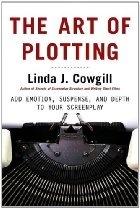Linda J. Cowgill, The Art of Plotting: Add Emotion, Suspense, and Depth to your Screenplay (Lone Eagle 2007)
 It’s been quite a while since I’ve blogged about my reading, and this book is a partial explanation. (The rest of the explanation lies in small matters like a nephew’s wedding, paid work, dense bedside reading, too much television.)
It’s been quite a while since I’ve blogged about my reading, and this book is a partial explanation. (The rest of the explanation lies in small matters like a nephew’s wedding, paid work, dense bedside reading, too much television.)
The person sometimes known in the blog as the Film Director has been at me to write a feature film script to build on our modest success with Ngurrumbang (which incidentally just screened at the Human Rights Arts and Film Festival in Melbourne and is scheduled for the St Kilda Film Festival on Saturday week). I don’t share his confidence in my ability but I’m up for the challenge, so I’ve just done an online course in Screenwriting for Film through AFTRS, and am well on the way to the beginnings of a first draft – though not the one the FD wants. The course was brilliant. Anne Brooksbank, the teacher, led 15 or so of us in two chat sessions a week for 10 weeks and commented on weekly assignments, managing to be both encouraging and challenging, collegial and inspirational. She made us watch some awful films as well as some brilliant ones, and we learned from both kinds.
One of the lesser things I learned was how to read a book like this one. You have to ignore the occasional motivational-speaker language (too many sentences starting ‘Great screen writers …’), and not get too snooty about the movies used as examples (I didn’t care much for American Beauty, and hadn’t seen Se7en – which I have now watched because of this book, and on the whole wish I could unwatch). You have to realise that the way things like structure, character or theme used to be discussed in Eng Lit courses (and probably still are, only more so) may be more fun, but is very different from the way you talk about building them. This isn’t a manual, but it’s immensely practical. It assumes knowledge of the established wisdom about structure – assumes the equivalent of the course I’ve just done. I don’t know how it stacks up against the myriad similar books out there, but I found it clear and helpful. I imagine it works best if, like me, you have a project more or less under way, so when Linda Cowgill talks about, say, having a logical progression from one scene to the next, or informing the audience about a character not by telling, or by showing, but by dramatising, you have examples of your own work fresh in your mind and can immediately see how the advice can be applied.


I’ve read a few books of screenwriting and found it didn’t matter too much which ones and exactly what they were advising. It’s just a useful way to reflect on your own work and to give yourself ideas when stuck.
LikeLike
That’s so interesting coming from you, Richard. So the helpfulness of such books never disappears altogther?
LikeLike